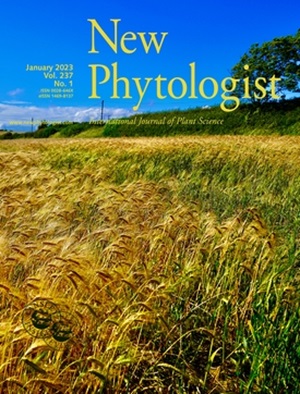隐喻电路的短路:在叶片气体交换的欧姆类比中,维管分区和气孔斑块会造成明显的不饱和和二氧化碳梯度反转。
IF 8.1
1区 生物学
Q1 PLANT SCIENCES
引用次数: 0
摘要
对叶片气体交换的分析依赖于将单个气孔、内部空气空间和叶肉传导串联起来的欧姆类比。这种模型是叶肉传导和叶片空气空间相对湿度推断的基础,据报道,叶肉传导和叶片空气空间相对湿度可低至 80%。一个悬而未决的问题是,这种串联模型对真实叶片是否有偏差,因为真实叶片的内部气室在不同尺度上都有脉管。为了测试不饱和是否可能源于建模伪影,我们比较了具有不同分布和大小的叶片表面传导("斑块")的腔室叶片的系列模型估计值和真实参数值。表面电导率的分布会给气体交换计算带来很大偏差。表观不饱和和内部二氧化碳梯度反转都可以通过与表面传导性下降一致的更广泛的气孔孔径分布演变产生,这可能发生在蒸气压不足增加的情况下。在气体交换实验中,由简单序列模型定义的导出量的行为对通量和气孔孔径在叶片表面的真实分布非常敏感。我们需要新的方法来将模型的假象与真实的生物反应区分开来。本文章由计算机程序翻译,如有差异,请以英文原文为准。

Shorting the metaphorical circuit: vascular partitioning and stomatal patchiness can create apparent unsaturation and CO2 gradient inversion in the Ohmic analogy for leaf gas exchange
- Analyses of leaf gas exchange rely on an Ohmic analogy that arrays single stomatal, internal air space, and mesophyll conductances in series. Such models underlie inferences of mesophyll conductance and the relative humidity of leaf airspaces, reported to fall as low as 80%. An unresolved question is whether such series models are biased with respect to real leaves, whose internal air spaces are chambered at various scales by vasculature.
- To test whether unsaturation could emerge from modeling artifacts, we compared series model estimates with true parameter values for a chambered leaf with varying distributions and magnitudes of leaf surface conductance (‘patchiness’).
- Distributions of surface conductance can create large biases in gas exchange calculations. Both apparent unsaturation and internal CO2 gradient inversion can be produced by the evolution of broader distributions of stomatal apertures consistent with a decrease in surface conductance, as might occur under increasing vapor pressure deficit.
- In gas exchange experiments, the behaviors of derived quantities defined by simple series models are highly sensitive to the true partitioning of flux and stomatal apertures across leaf surfaces. New methods are needed to disentangle model artifacts from real biological responses.
求助全文
通过发布文献求助,成功后即可免费获取论文全文。
去求助
来源期刊

New Phytologist
生物-植物科学
自引率
5.30%
发文量
728
期刊介绍:
New Phytologist is an international electronic journal published 24 times a year. It is owned by the New Phytologist Foundation, a non-profit-making charitable organization dedicated to promoting plant science. The journal publishes excellent, novel, rigorous, and timely research and scholarship in plant science and its applications. The articles cover topics in five sections: Physiology & Development, Environment, Interaction, Evolution, and Transformative Plant Biotechnology. These sections encompass intracellular processes, global environmental change, and encourage cross-disciplinary approaches. The journal recognizes the use of techniques from molecular and cell biology, functional genomics, modeling, and system-based approaches in plant science. Abstracting and Indexing Information for New Phytologist includes Academic Search, AgBiotech News & Information, Agroforestry Abstracts, Biochemistry & Biophysics Citation Index, Botanical Pesticides, CAB Abstracts®, Environment Index, Global Health, and Plant Breeding Abstracts, and others.
 求助内容:
求助内容: 应助结果提醒方式:
应助结果提醒方式:


